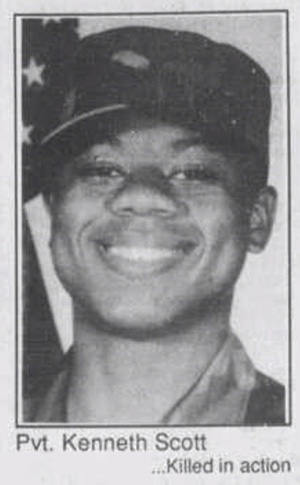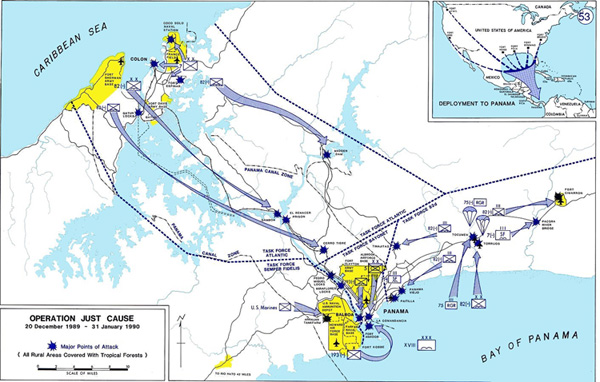
Used with permission

Remember...
Kenneth Douglas Scott
1969-1989
"Whatever happened, there was a reason. Tell everybody in the family and my friends that my death was for a good cause."
Private Roy Dennis Brown Jr.
Kenneth Douglas Scott was born on May 20, 1969, in Princeton, West Virginia, in Mercer County. He was born to Charles T. Scott and Elizabeth J. Hall Scott. He had four brothers, Charles Andrew Scott, William Edward Hall, and Thomas Alexander Hall, all of Princeton, West Virginia, and James Michael Hall of Charleston, West Virginia. He also had a sister named Melissa Roxana Scott of Princeton, West Virginia. He attended school in the Princeton Public School System and was a member of the J. H. Easley Tabernacle Church in Princeton. For seven years of his life he was under the guardianship of Mrs. Ruth Palmer of Princeton, West Virginia. For 20-year-old Kenneth D. Scott, the Army was his family, especially after his sister was killed by her husband. "This place held nothing but bad things for him," said Darrell Henderson, a cousin. "The Army was the easiest way to get away."
During his childhood, the U.S. was going through changes in civil rights, skepticism and acceptance of the immorality of racial segregation, and environmental movements. Long hair and outrageous clothing were in style. There was also the energy crisis, the Vietnam War, and the Watergate scandal.
Kenneth Scott enlisted in the U.S. Army as an infantryman on June 15, 1989 as a Private E-2 (PV2). After his basic and advanced individual training, he was assigned to Alpha Company, 4th Battalion, 6th Infantry Regiment, 5th Infantry Division (Mechanized), stationed at Fort Polk, Louisiana. Shortly after his arrival, his unit was deployed to Panama in support of Operation Just Cause. Their goal was to capture General Noriega, who had taken over the government in Panama. General Noriega was originally on the CIA's payroll until the U.S. began an anti-communist policy. The U.S. was dealing with a cocaine problem, and Panama was considered the main transfer point for shipments to the U.S. General Noriega was said to be a drug dealer and was to be brought to the U.S. to face drug charges. In 1992, Noriega was convicted of eight counts of drug trafficking and conspiracy.
In the early morning hours of December 20, 1989, the United States Army spearheaded a carefully planned and well-executed attack that overwhelmed the Panamanian Defense Forces (PDF) of the dictator Manuel Noriega. The goal was to restore the democratically elected government of Guillermo Endara and arrest Noriega on drug trafficking charges. At the time, Operation Just Cause was the largest and most complex combat operation since the Vietnam War. Nearly 26,000 combat troops deployed, with just under half being from bases in the United States. Two dozen targets were attacked throughout the country using a wide spectrum of tactical operations, including Military Operations on Urbanized Terrain (MOUT), Air-Assault, Airborne, and Special Forces. Thorough planning was conducted with regard both to the operational aspects as well as to the political implications of forcibly removing Noriega from power. Through emphasis on realistic small-unit training, the U.S. Army successfully accomplished its mission, decisively neutralizing Noriega's forces, restoring the elected democratic government, protecting American lives, and minimizing Panamanian casualties.

Map of US-Operation Just Cause, Invasion of Panama, December 1989 - January 1990. This image is a work of a U.S. military or Department of Defense employee, taken or made as part of that person's official duties.
As a work of the U.S. federal government, the image is in the public domain in the United States.
The 4th Battalion, 6th Infantry, was organized under Task Force Bayonet, which had the responsibility of taking the PDF headquarters, La Comandancia, located within Panama City. The Task Force, supported by four M551 Sheridans and four Marine light armored vehicles, captured the PDF nerve center by the afternoon. Bayonet also had to protect the Americans living on Fort Amador from the PDF soldiers also stationed there. Alpha Company had been assigned to Task Force Gator, which had the responsibility of setting up five roadblocks at critical intersections to block any PDF reinforcements that might show up from Tinajitas, Panama Viejo, and Fort Cimarron.
After ensuring the safety of all friendlies, the 1st Battalion, 508th Infantry (Airborne), supported by a 105-mm howitzer in direct-fire mode and a Spanish recording calling on the PDF to surrender, convinced most of the enemy to voluntarily leave their barracks-thus preventing much unnecessary bloodshed on both sides.
However, during the first day of combat operations, PV2 Kenneth Scott was killed on December 20th, 1989, while conducting a strategic road block at an intersection in the Hollywood section of Panama City. Someone hiding in a neighboring building shot him with an AK-47. At the age of 20, PV2 Kenneth Douglas Scott was one of 23 U.S. service members killed during combat operations. He was laid to rest at Roselawn Memorial Gardens in Princeton, West Virginia. He was mourned by many, including his foster parents and the woman he was going to marry when he returned from his deployment.
Jayda McHorney and Richard (Luke) Nichols, George Washington High School JROTC
January 2019

West Virginia Archives and History welcomes any additional information that can be provided about these veterans, including photographs, family names, letters and other relevant personal history.